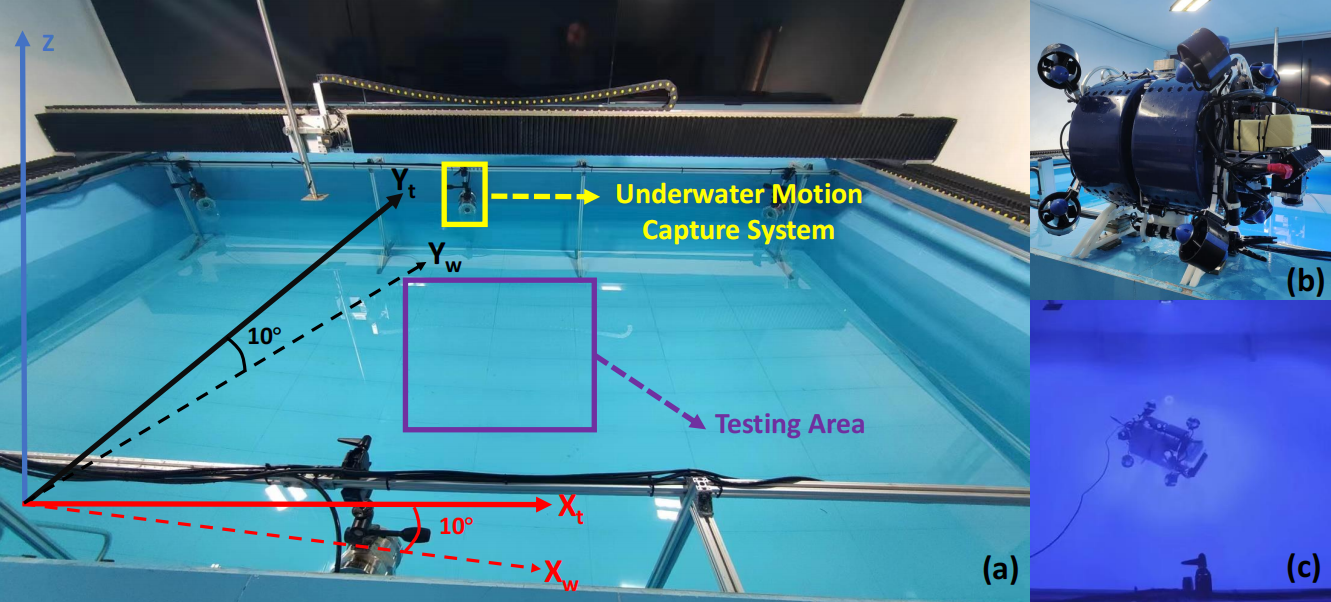A joint research team from Dalian Maritime University, Yichang Institute of Test and Research, and the University of Nevada, Reno, presented a paper titled “Model Predictive Control for an Autonomous Underwater Robot with Fully Vectored Propulsion” at this year's ICRA conference.
This paper designs and manufactures an autonomous underwater robot with a fully vectored propulsion system featuring eight distributed thrusters. It also describes the necessary hardware platform and software architecture for autonomous underwater control. The authors developed the robot's control system based on Model Predictive Control (MPC). Simulation and real-world experimental results demonstrate that the robot possesses precise movement capabilities, highlighting its potential application in marine operations.
In offshore industries, diving operations pose health risks to divers. In the 1990s, the emergence of Remotely Operated Vehicles (ROVs) replaced human labor for underwater tasks, reducing costs and improving safety. However, operating ROVs typically requires skilled operators, support from a mothership, and tether cables, which limits their operational range and applicability. Therefore, developing autonomous underwater robots with control capabilities holds significant practical importance.
1. The authors of this paper proposed a fully vectored propulsion autonomous underwater robot, which improves thruster efficiency and enhances the robot's flexibility and agility underwater. By integrating onboard edge computing devices, sensors, and actuators, the robot can operate autonomously.

2. The software architecture of the robot was built based on ROS, ensuring efficient information transmission between the perception, planning, and control modules.

3. The authors conducted theoretical modeling and parameter identification, then used a model predictive control method based on physical constraints for real-time prediction and optimization of the fully vectored robot's state to achieve autonomous control.
To the authors' knowledge, there are currently no such fully vectored autonomous underwater robots.
1. Numerical simulation experiments:
The experimental results demonstrated the effectiveness of the proposed MPC controller and confirmed the feasibility of applying such a controller to the fully vectored underwater robot design.
2. Real-world experiments:The real-world experiments were conducted in an indoor rectangular water tank with dimensions of 5 meters × 3 meters × 1.5 meters. Six underwater cameras from the NOKOV metric motion capture system were set up around the tank and recorded position and velocity data with sub-millimeter accuracy at a sampling rate of 100 Hz. Attitude data was also collected based on AHRS.

Ultimately, point-to-point movement experiments with the robot demonstrated the feasibility of the robot’s system design and the effectiveness of the MPC controller.
NOKOV motion capture system’s underwater cameras provided high accuracy position and velocity data for the robot, and helped verify the feasibility of the robot’s system design and the effectiveness of the MPC controller.
Gao Tianzhu is a PhD student at the School of Information Science and Technology, Dalian Maritime University, and the Liaoning Provincial Underwater Robot Engineering Research Center. Research interests: underwater robots, model predictive control.
Luo Yudong (Corresponding Author) is an Associate Professor at the School of Information Science and Technology, Dalian Maritime University, and the Liaoning Provincial Underwater Robot Engineering Research Center. Research interests: intelligent unmanned systems, robotic autonomy, underwater robots.
Lü Chao is a master’s student at the School of Information Science and Technology, Dalian Maritime University, and the Liaoning Provincial Underwater Robot Engineering Research Center. Research interests: underwater robots, behavioral decision-making, and motion planning.
Luo Weirong is a master’s student at the School of Marine Engineering, Dalian Maritime University, and the Mechatronics Laboratory. Research interests: large-span cable-driven parallel robot motion control.
Fu Xianping is the Director of the Liaoning Provincial Underwater Robot Engineering Research Center and PhD supervisor at the School of Information Science and Technology, Dalian Maritime University. Research interests: underwater robots, computer vision.
Zhao Na is a lecturer and master's supervisor at the School of Information Science and Technology, Dalian Maritime University. Research interests: intelligent unmanned systems, multimodal robots, robot dynamics and control.Luo Xi is the Chief Designer and Senior Engineer at the Yichang Test Technology Research Institute. Research interests: underwater unmanned vehicle propulsion, multi-source fusion situational awareness.
Yantao Shen is a professor at the University of Nevada, Reno. Research Areas: Biomimetic robots, sensors and instruments.